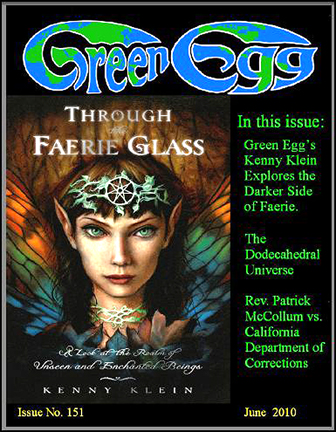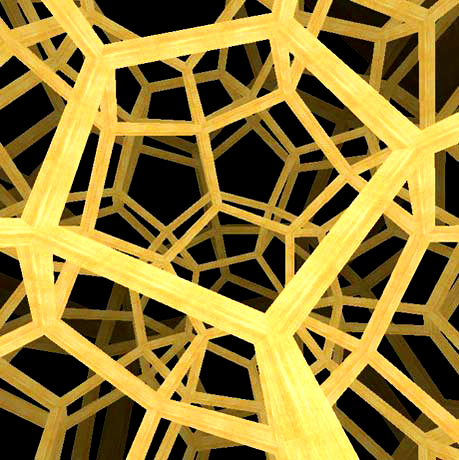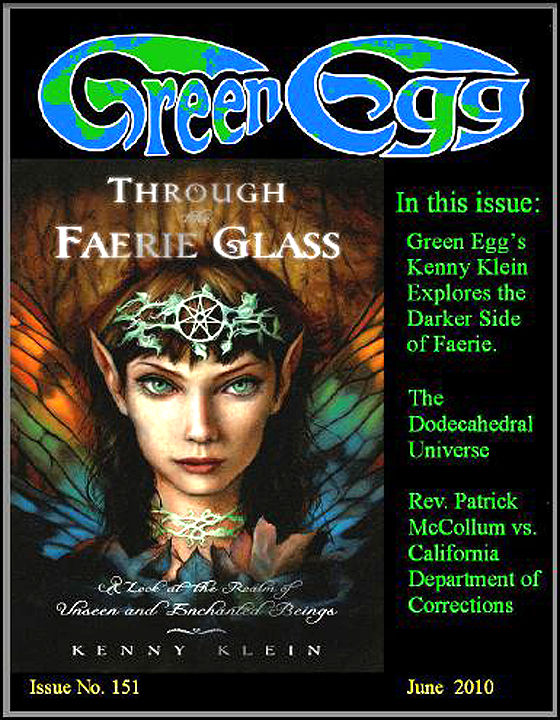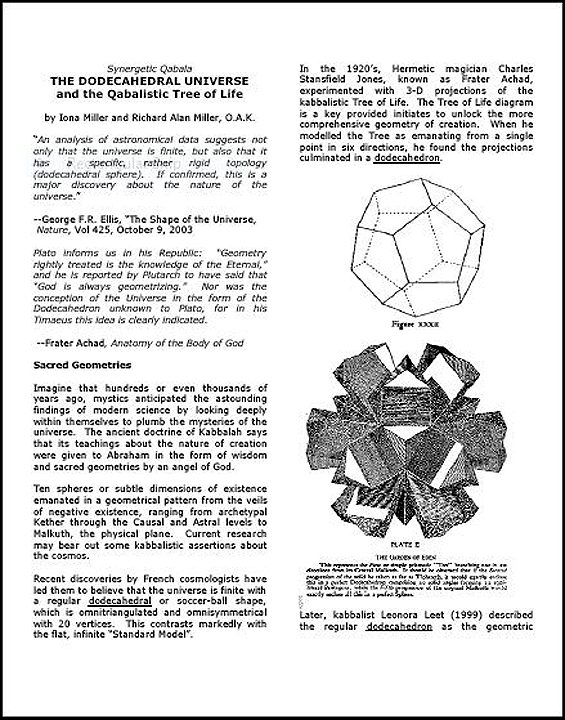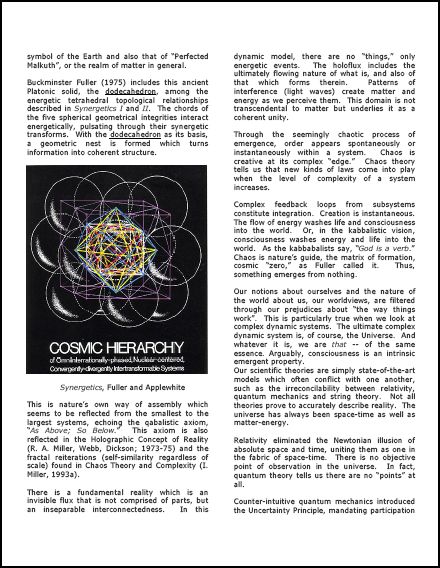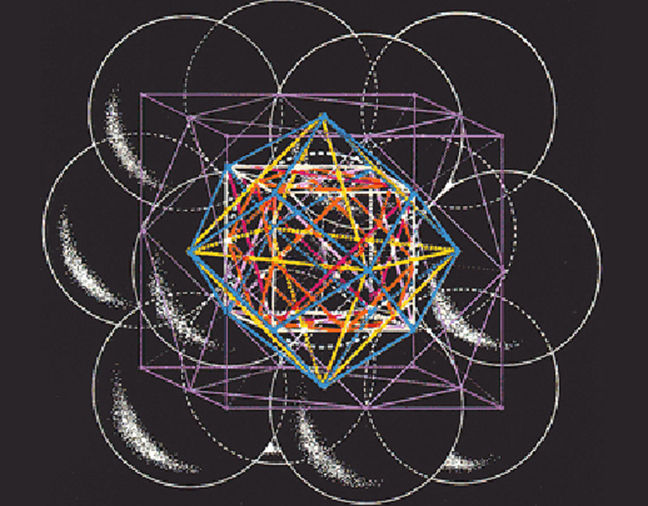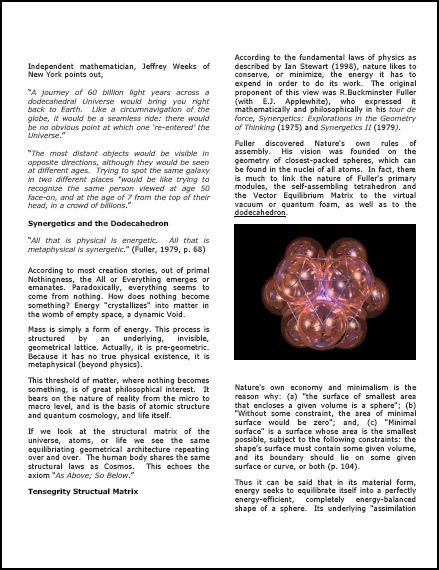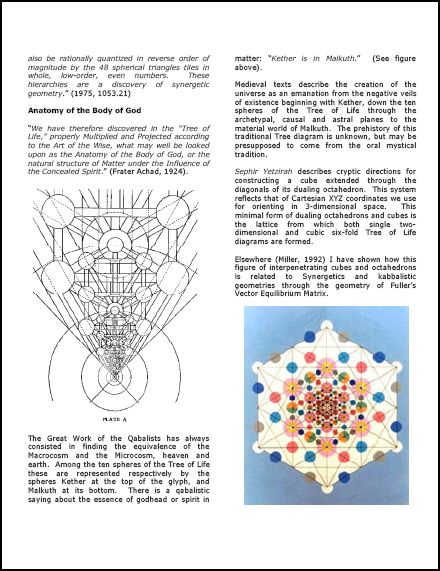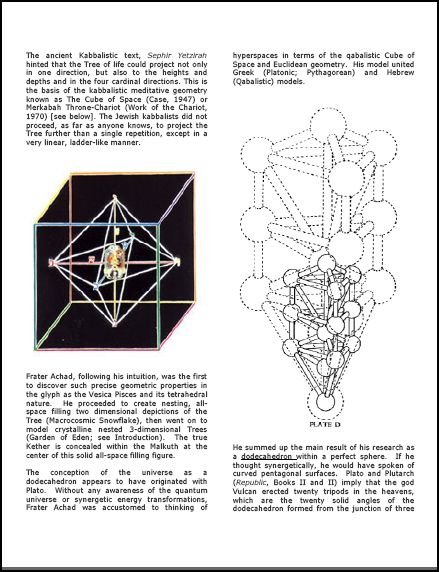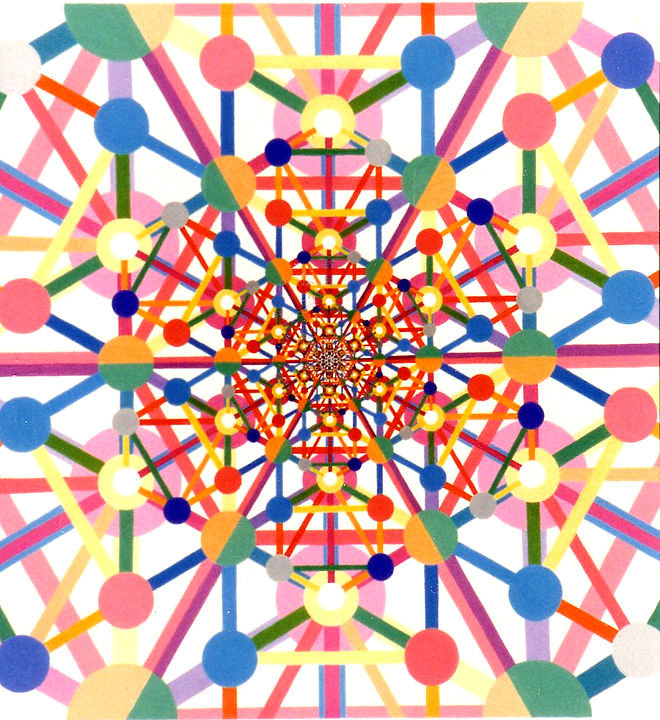Dodecahedral Universe
GREEN EGG MAGAZINE, Issue 151, June 2010 -
The Dodecahedral Universe & the Qabalalistic Tree of Life
Synergetic Qabala http://zero-point.tripod.com/
THE DODECAHEDRAL UNIVERSE
and the Qabalistic Tree of Life
by Iona Miller, O.A.K., 11/2003
“An analysis of astronomical data suggests not only that the universe is finite, but also that it has a specific, rather rigid topology (dodecahedral sphere). If confirmed, this is a major discovery about the nature of the universe.” -George F. R. Ellis, “The Shape of the Universe,” Nature, Vol 425, October 9, 2003
Plato informs us in his Republic: “Geometry rightly treated is the knowledge of the Eternal,” and he is reported by Plutarch to have said that “God is always geometrizing.” Nor was the conception of the Universe in the form of the Dodecahedron unknown to Plato, for in his Timaeus this idea is clearly indicated. [see http://www.mlahanas.de/Greeks/PlatoSolid.htm for more on Plato's DodecaVerse] --Frater Achad, Anatomy of the Body of God
Sacred Geometries
Imagine that hundreds or even thousands of years ago, mystics anticipated the astounding findings of modern science by looking deeply within themselves to plumb the mysteries of the universe. The ancient doctrine of Kabbalah says that its teachings about the nature of creation were given to Abraham in the form of wisdom and sacred geometries by an angel of God.
Ten spheres or subtle dimensions of existence emanated in a geometrical pattern from the veils of negative existence, ranging from archetypal Kether through the Causal and Astral levels to Malkuth, the physical plane. Current research may bear out some kabbalistic assertions about the cosmos.
Recent discoveries by French cosmologists have led them to believe that the universe is finite with a regular dodecahedral or soccer-ball shape, which is omnitriangulated and omnisymmetrical with 20 vertices. This contrasts markedly with the flat, infinite “Standard Model”.
In the 1920’s, Hermetic magician Charles Stansfield Jones, known as Frater Achad, experimented with 3-D projections of the kabbalistic Tree of Life. The Tree of Life diagram is a key provided initiates to unlock the more comprehensive geometry of creation. When he modelled the Tree as emanating from a single point in six directions, he found the projections culminated in a dodecahedron.
Later, kabbalist Leonora Leet (1999) described the regular dodecahedron as the geometric symbol of the Earth and also that of “Perfected Malkuth”, or the realm of matter in general.
Buckminster Fuller (1975) includes this ancient Platonic solid, the dodecahedron, among the energetic tetrahedral topological relationships described in Synergetics I and II. The chords of the five spherical geometrical integrities interact energetically, pulsating through their synergetic transforms. With the dodecahedron as its basis, a geometric nest is formed which turns information into coherent structure. [for more on Sacred Geometry, see http://sacredgeometry.50megs.com/ ]
Synergetics, Fuller and Applewhite
This is nature’s own way of assembly which seems to be reflected from the smallest to the largest systems, echoing the qabalistic axiom, “As Above; So Below.” This axiom is also reflected in the Holographic Concept of Reality (R. A. Miller, Webb, Dickson; 1973-75) and the fractal reiterations (self-similarity regardless of scale) found in Chaos Theory and Complexity (I. Miller, 1993a).
There is a fundamental reality which is an invisible flux that is not comprised of parts, but an inseparable interconnectedness. In this dynamic model, there are no “things,” only energetic events. The holoflux includes the ultimately flowing nature of what is, and also of that which forms therein. Patterns of interference (light waves) create matter and energy as we perceive them. This domain is not transcendental to matter but underlies it as a coherent unity. [for more on Synergetics & Qabala, see http://www.members.tripod.com/sourceress/index.html ]
Through the seemingly chaotic process of emergence, order appears spontaneously or instantaneously within a system. Chaos is creative at its complex “edge.” Chaos theory tells us that new kinds of laws come into play when the level of complexity of a system increases.
Complex feedback loops from subsystems constitute integration. Creation is instantaneous. The flow of energy washes life and consciousness into the world. Or, in the kabbalistic vision, consciousness washes energy and life into the world. As the kabbabalists say, “God is a verb.” Chaos is nature’s guide, the matrix of formation, cosmic “zero,” as Fuller called it. Thus, something emerges from nothing.
Our notions about ourselves and the nature of the world about us, our worldviews, are filtered through our prejudices about “the way things work”. This is particularly true when we look at complex dynamic systems. The ultimate complex dynamic system is, of course, the Universe. And whatever it is, we are that -- of the same essence. Arguably, consciousness is an intrinsic emergent property.
Our scientific theories are simply state-of-the-art models which often conflict with one another, such as the irreconcilability between relativity, quantum mechanics and string theory. Not all theories prove to accurately describe reality. The universe has always been space-time as well as matter-energy.
Relativity eliminated the newtonian illusion of absolute space and time, uniting them as one in the fabric of space-time. There is no objective point of observation in the universe. In fact, quantum theory tells us there are no “points” at all.
Counter-intuitive quantum mechanics introduced the Uncertainty Principle, mandating participation rather than observation. It shows us that at the smallest level we can only make statistical predictions about how nature will manifest from waves of probability. And the non-linear equations of chaos theory imply dynamic processes are actually deterministic though unpredictable.
While providing a unified vision, the holographic concept doesn’t provide equations to unite all the forces of nature. Yet it reminds us of the holistic perspective that each part contains the whole, even though at a lower level of resolution. Physics demands experimentation while astrophysics relies largely on ever-sharper observation to determine the nature of our existence.
All these disciplines interrelate in certain specialty fields such as quantum cosmology, consciousness studies, transpersonal psychology, and metaphysics - that which by its very nature emerges from a domain beyond the physical, the realm of Source.
Our models still cannot completely reconcile the physics of the very small and the very large. Untestable theories which make no predictions are essentially philosophy rather than good science. Conversely, a strong argument can also be made that scientific ‘materialism’ is essentially a philosophy.
String theory, for example, remains a philosophy or conceptual paradigm, since no experiments can yet be devised to prove its applicability. Nor are they likely to be in the foreseeable future. It alleges that the essence of all manifest reality is vibrating strings, tiny one dimensional loops (rather than the quarks of quantum mechanics). These infinitesimal strings are the building blocks of matter.
Some kinds of string theory have open strings; some have closed circles. Some have one kind of vibration while others called heterotic have different kinds of vibrations moving in opposite directions.
Several of the superstring theories and one supergravity theory all fit into a kind of ecosystem called M-theory (for matrix or magic, take your pick), which is an alternative description of the same phenomena. The string part is natural because a point particle has an infinite energy singularity whereas a tiny string isn’t a point of energy but rather a base vibration.
All these theories are supersymmetric in 10 or so dimensions, meaning each force-carrying boson is paired with a matter-forming fermion but our particles are nn-symmetric in 4 dimensions. Our fermions, like the neutrino, electron, and proton don’t pair up in any kind of ‘arranged marriage’ with the photon or graviton or any other force particle.
Schwarz calls the Second String Revolution the finding that the formerly competing versions of string theory are actually variations on a theme, and the theme is M-theory. A nagging problem, already recognized in the work of Kaluza and Klein, has been: What of these extra dimensions? Where are they? Why do we never see them?
To get from one to the other requires compactifying the 6 or so extra dimensions. There are millions of ways of doing this and one or two might produce the odd array of particles we find. So the theories aren’t just philosophy but they might as well be unless we can figure out which one if any really coincides with nature.
Strings are orders of magnitude smaller than atoms, yet condition their various subatomic manifestations, such as quarks, protons, neutrons and electrons. Observed particle properties are a reflection of the various ways a string can vibrate.
Each preferred pattern of resonant vibration appears as a particle determined by the oscillatory pattern (Greene, 1999). This pervasive resonance phenomenon is literally the Music of the Spheres of ancient philosophy.
A string field includes the number of possible configurations of a string in space. It is related to a new kind of geometry in an enormous extension of the idea of space. It is defined by all the possible configurations of a string.
Strings act like point particles. However, a stringlike particle should be thought of as a “wavelike” disturbance in that huge space, just as a graviton is a wave in ordinary space. The interference of these wavelike disturbances could, indeed, be the holographic domain.
One version of string theory posits our four manifest dimensions (3-D + time) are undergird by 6 subtle enfolded dimensions curled up unobservably in space-time, according to the mathematics. This 10-dimension theory reminds of the qabalistic notion of 10 spheres, with only the lower four being manifest while the other six are more fundamental emanations.
String theory, because of the inelegance of its multiple solutions is being superceded by M-theory or Membranes, with branes or p-branes as fundamental phenomena. M-theory relies on supersymmetry. This supersymmetry transforms the coordinates of space-time so the laws of physics become the same for all observers, implying gravity.
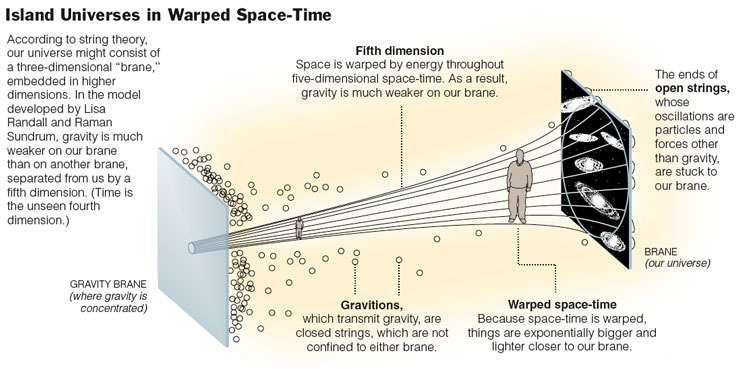
In M-theory, everything may arise from strings, bubbles and sheets in higher dimensions of space-time. Membranes take the shape of them all. M-theory has 11 dimensions so it is more fundamental perhaps than strings. Gravity is the geometry of space-time. “Matrix” theory is based on an infinite number of zero-branes (particles). Their coordinates are not ordinary numbers but matrices, making space-time a fuzzy concept.
A testable holistic model is the Holy Grail of science, a “theory of everything”, or T.O.E. uniting all the forces of nature, including gravity. In principle it would explain everything from the macroscopic Big Bang to the most elusive microscopic phenomena. Yet it has remained elusive. However, science is only roughly 200 years old and growing exponentially.
Some philosophies, on the other hand, such as Kabbalah claim up to a 4,000 year lineage. The Jewish kabbalists had a holistic theory of everything including mankind’s relationship to cosmos depicted in their Tree of Life diagram. It is a holographic encyclopedia of phenomenology. It is a graphic display of the unity of micro- and macrocosm, of how man and universe interpenetrate and reflect one another.
Does our psychobiology somehow condition or reflect our philosophies? Reality seems to depend on how you look at it. Were the ancient mystics prescient? Were they somehow able to intuitively perceive the true nature of the cosmos by looking into themselves?
Intuition is a non-linear informational source which creates “quantum leaps” in our awareness. But mystics have also always spoken of the illusory nature of consensus reality. However, without the matrix of theory, data flies by incomprehensibly, its deeper meaning lost. If so, how does what the ancients discovered relate to current scientific findings? Can we know the nature of the universe if we do not even know ourselves?
The ancient philosophers corresponded the dodecahedron with the fifth element, Ether, or the Universe. We can examine its symbolic and phenomenological manifestations at the macro- and micro levels in both science and metaphysics.
The Shape of the Universe
“An analysis of astronomical data suggests not only that the universe is finite, but also that it has a specific, rather rigid topology (dodecahedral sphere). If confirmed, this is a major discovery about the nature of the universe.”
--George F. R. Ellis, “The Shape of the Universe,”
Nature, Vol 425, October 9, 2003
In early October of 2003, a team of French astrophysicists announced that rather than flat and endless, the cosmos is shaped like a soccer ball, with curved pentagonal-shaped panels. Their discovery comes from mapping the all-pervading microwave radiation released during the Big Bang over 13 billion years ago.
Fluctuations in temperature, (like waves in the ocean), at the extreme ranges of the radiation do not match the Standard Model. There are no large waves which would be expected in an infinite universe. Data showing fluctuating density is arguably consistent with the cosmos being a Poincare dodecahedral space. This finite spherical solid universe would be contained by 12 curved pentagons.
Independent mathematician, Jeffrey Weeks of New York points out,
“A journey of 60 billion light years across a dodecahedral Universe would bring you right back to Earth. Like a circumnavigation of the globe, it would be a seamless ride: there would be no obvious point at which one ‘re-entered’ the Universe.”
“The most distant objects would be visible in opposite directions, although they would be seen at different ages. Trying to spot the same galaxy in two different places “would be like trying to recognize the same person viewed at age 50 face-on, and at the age of 7 from the top of their head, in a crowd of billions.”
Synergetics and the Dodecahedron
“All that is physical is energetic. All that is metaphysical is synergetic.” (Fuller, 1979, p. 68)
According to most creation stories, out of primal Nothingness, the All or Everything emerges or emanates. Paradoxically, everything seems to come from nothing. How does nothing become something? Energy "crystallizes" into matter in the womb of empty space, a dynamic Void.
Mass is simply a form of energy. This process is structured by an underlying, invisible, geometrical lattice. Actually, it is pre-geometric. Because it has no true physical existence, it is metaphysical (beyond physics).
This threshold of matter, where nothing becomes something, is of great philosophical interest. It bears on the nature of reality from the micro to macro level, and is the basis of atomic structure and quantum cosmology, and life itself.
If we look at the structural matrix of the universe, atoms, or life we see the same equilibriating geometrical architecture repeating over and over. The human body shares the same structural laws as Cosmos. This echoes the axiom “As Above; So Below.”
more at http://sacredgeometry.50megs.com/custom2.html
*
*
Sample Photo 1
It's long been thought that the Universe could be finite, though expanding. A good analogy is to imagine a flatland in 2 dimensions. Rather than this 2D universe being flat like a piece of paper of infinite size, it's more like the surface of a slowly expanding balloon. So if a flatland spaceship travelled in its 2D space in a straight line, it would eventually arrive back where it started. The inhabitants would deduce that their 2D space must be curved in some higher dimension they can't perceive, only deduce.
So what would be the effect of a higher dimensional curvature on our own 3D space? With a powerful enough telescope, we could look in certain directions, and see an image of things at the edge of perception. We'd expect to look in the opposite direction, and see the same thing. Except that doesn't work too well, as we'd expect to see the same sort of thing no matter which way we look, and that's not compatible with a sphere, the Universe would have to be faceted, one of the regular solids - a tetrahedron, a cube, an octahedron, a dodecahedron, or an icosahedron.
It would be likely that each facet would appoximate a disk - and the closest approximation is each pentagonal side of a dodecahedron.
The idea of a balled-up universe was first proposed in 2003 by Jean-Pierre Luminet at the Paris Observatory, France, as a way to explain some odd patterns in the cosmic microwave background - the afterglow of the big bang. The CMB contains warmer and cooler splotches, which reflect the density variations of the universe in its youth. This fits nicely with cosmological models, except that if you blur the microwave map into big enough pixels, the splotches disappear and the map looks less random than you'd expect - and nobody can explain why.
Luminet and his colleagues suggested that this might be because the universe is finite, but is wrapped around on itself. This means that if a spaceship could cross the universe and "exit" through one side, it would still be in the same region of space but would "re-enter" from the opposite side of the universe. Because of this wrap-around effect, images of everything in the universe would appear to be repeated in the CMB. The best way to explain the data was if the universe is like a dodecahedron - a ball-like shape with a surface of 12 identical pentagons.
Boudewijn Roukema, an astronomer at the Nicolaus Copernicus University in Poland, and his colleagues have reached another conclusion: the team "cut" rings from a version of the WMAP data taken from opposite sides of the sky, twisted the cut-out rings relative to each other and looked for matches. They also considered variations in the orientation of the entire dodecahedron over the sky to ensure that some of their pairs of rings were cut from opposite flat sides of the dodecahedron instead of from its corners or edges.
They found that those rings were a close match if one ring was rotated by about 36 degrees around their perpendicular axis (see Diagram). Importantly, calculations for a dodecahedral universe predict that this is the angle you would see.

So how big is the Universe? Quite small, really. From the original 2003 New Scientist article, before the 36 degree twist was found:
If confirmed, they would indeed be stunning. They would mean that the Universe is relatively small, something like 70 billion light years across. What's more, we could in theory see the entire cosmos and check that there are no hidden corners where the laws of physics are different.Like many hypotheses in Science, it may not even be in the right ballpark (so to speak). But the evidence is getting stronger that this may indeed be the case.
For instance, it would rule out exotic ideas such as chaotic inflation, which suggests our local Universe is just one of myriad expanding bubbles beyond eyeshot, each with slightly different physical laws.
It would also banish the philosophical paradoxes of an infinite Universe, such as the idea that every person on Earth has an infinite number of alien doubles leading parallel lives. "If we could prove that the Universe was finite and small, that would be earth-shattering," says David Spergel of Princeton University in New Jersey. "It would really change our view of the Universe."
Sample Photo 2
The Universe may be revealing its shape, new findingings suggest
Oct. 6, 2004
Special to World Science
For centuries, scientists, philosophers and ordinary people have wondered whether the universe is infinite, and what its shape might be. In two recent studies, scientists say signals from the explosion that gave rise to the universe may be leading them to answers to both questions.
 |
| Some researchers say the universe may be shaped like a dodecahedron, in which objects that go out one side come back in the opposite. (Image courtesy Paris Observatory) |
As for whether the universe is infinite, these signals point to “no,” the researchers say.
As for its shape, if ever a shape could be at once hauntingly beautiful, yet impossible to draw or visualize exactly, this one might be it. But roughly, it would resemble a dodecahedron, a 12-sided box similar to some dice used in the popular role-playing game Dungeons & Dragons.
Some researchers disagree with the findings. “I’d be happy to wager a bottle of scotch against the dodecahedral universe,” wrote cosmologist Ned Wright, of the University of California at Los Angeles, in a recent email.
The dodecahedral universe claims are based on observations of the furthest reaches of our universe. Since light takes time to travel, the further we peer out into space with telescopes, the further back in time we see. If we look far enough, we can see the aftermath of the “Big Bang,” a tremendous explosion that astronomers believe created our universe.
The radiation from this explosion tells us some things about the early universe. In particular, it reveals the approximate density of different areas of the universe during that early time. Slight variations in the density of different parts of the early universe result in corresponding variations in the radiation’s temperature.
These variations follow patterns in space that, mathematically, are identical to the vibration patterns of a musical instrument as it’s being played.
Such vibrations that they normally come at many size scales, depending on the size of the instrument. When a bell rings, there are large ripples that span its whole surface, and tiny ones, but none bigger than the bell itself. The size of the largest ripples would reveal the size of the bell. The universe is thought to work similarly: the size of the biggest ripples could give astronomers some idea of the size of the universe.
In the case of the universe, ripples could conceivably be found in a very wide range of sizes. But they’re not found in all these sizes; ripples larger than a certain size aren’t seen. The most natural explanation of this seems to be that space is finite, say Jean-Pierre Luminet of the Paris Observatory, France, and colleagues. This is because only a universe of limited size could easily explain why the ripples are also limited in size. “Just as the vibrations of a bell cannot be larger than the bell itself, the density fluctuations in space cannot be larger than space itself,” he wrote in the research journal Nature last fall.
This leftover light from the Big Bang – called the cosmic microwave background – may also reveal the shape of the universe, Luminet and colleagues argue. They claim that the details of the ripples point to a universe with a dodecahedral form described by the 19th- and early 20th- century French mathematician Henri Poincaré.
A peculiar aspect of this structure is that if we look out to one side of the dodecahedron, we see not a boundary, but our own universe all over again, as seen from the other side. It’s like a hall of mirrors, except that instead of seeing your face, you see the back of your head. In addition, you would see the images partially rotated.
In the September 2004 issue of the research journal Astronomy & Astrophysics, a group of researchers write that they has found “hints” of the structure Luminet described. If space is structured this way, researchers believe that the cosmic microwave background should exhibit a specific pattern called “matched circles.” This means that as we peer into space, certain areas of the radiation should look the same as other areas.
In the paper, Boudewijn F. Roukema of Copernicus University, Torun, Poland, and colleagues wrote that the patterns they found “correlate unusually well” with the matched-circles pattern required by Luminet’s theory. However, at present it’s hard to prove that this is not a coincidence, they wrote.
Wright is skeptical. The researchers “presented no evidence that this result was statistically significant,” he points out on his website. Luminet agrees: “Their result has to be confirmed by further statistical analysis,” he writes in an email. “The question remains open.”
If the findings turn out to be correct, professors may be kept busy for years explaining the shape of the universe to students. This is because the dodecahedron picture is an oversimplification. The actual theory has several strange twists.
In some video games, you can fly your spaceship off the edge of the screen and it comes back in from the opposite edge. A creature dwelling in the world of the video game would have the illusion of living in an infinite space, at least until it started moving around and realizing that things were repeating themselves everywhere.
In the same way, we may have the illusion of living in a much bigger universe than the real one, Luminet argues. This is because as we look far enough out with our telescopes, we begin to see the same objects repeatedly. However, we would see them partially rotated each time.
The reason for this rotation is that it allows our dodecahedral universe to fit into a bizarre mathematical creation called a hypersphere – a concept that requires some explanation.
Most people would consider a circle two-dimensional, and a ball three-dimensional. In fact, a ball is sort of a three-dimensional version of a circle. In the same way, mathematicians have invented “balls” that exist in four or more dimensions. These objects are impossible to picture, but they are perfectly real in a mathematical sense; in other words, one can do calculations with them, just as with a circle and a ball.
Now, the surface of a normal ball, or sphere, is two-dimensional. Thus it makes sense that the “surface” of a four-dimensional ball would be three-dimensional. This surface of a four-dimensional ball is just as impossible to visualize as the four-dimensional ball itself, but nonetheless, mathematicians have given a name to this type of surface: a hypersphere.
“A hypersphere is the 3-dimensional surface of a 4-dimensional ball,” wrote Luminet. Nineteenth-century mathematicians first devised the hypersphere as a possible shape of the universe. This served as a way to explain how space might be finite, yet have no boundary – just as the surface of a sphere has no boundary, yet doesn’t go on forever.
Understanding the hypersphere is first step toward understanding what, according to some researchers, is the shape of the universe. There is also another step or two.
Consider a soccer ball (or as non-Americans call it, a football). Its surface is covered with five-sided shapes, colored black and white. These shapes are basically pentagons, but not quite normal pentagons. Their edges are slightly bent, and their corner angles slightly different, compared to regular pentagons. These alterations allow these “modified pentagons” to fit snugly together on the surface of a ball. Otherwise, it couldn’t be a ball, but a shape like that of 12-sided die.
Now, return to the concept of a hypersphere. Remember, a hypersphere is the three-dimensional “surface” of a four-dimensional ball. If pentagons – which are basically two-dimensional – tile a three-dimensional soccer ball, it makes sense that some sort of three-dimensional objects can be said to tile the surface of a four-dimensional ball. It also makes sense that these would be three-dimensional versions of the “modified pentagons” described above.
These bizarre new objects are modified dodecahedrons: in other words, that 12-sided die shape again, but with slightly “bent edges.” It takes 120 of them to fill a hypersphere, the same way it takes 12 modified pentagons to cover a soccer ball. In the case of the universe, however, 119 of these dodecahedrons would be illusory, because they are all repeating images of a single one. Nonetheless, the hypersphere containing them is real – real enough to serve as a framework that determines the details of the shape and angles of the dodecahedron.
One outcome of the hypersphere framework is that objects leaving one face of the dodecahedron come back in the opposite face, but rotated partially. To be exact, the amount of the rotation is 36 degrees, which also happens to be the angle by which your direction would change if you turned a corner while walking along the edge of a pentagon.
Luminet admits that the accuracy of this whole theory remains to be confirmed. The claim that the universe is finite remains unproven, he says; its confirmation will require a more precise measurement of the density of the universe today. If the density is above a critical level, it will prove the universe is finite, he says. A better measurement of the density could come from the Planck Surveyor, a European spacecraft planned for launch in 2007 to study the birth of the universe.
“Since antiquity humans have wondered whether our universe is finite or infinite,” Luminet writes. “Now, after more than two millennia of speculation, observational data might finally settle this ancient question once and for all.”
